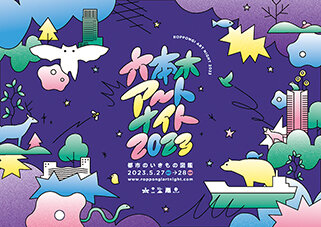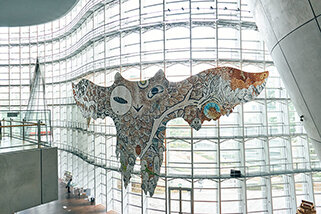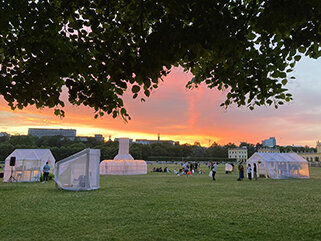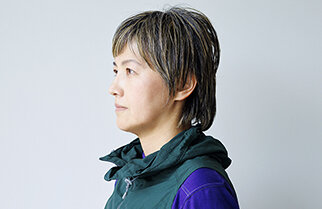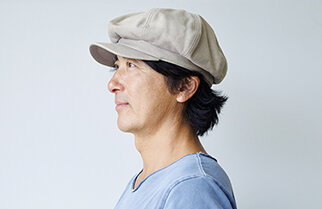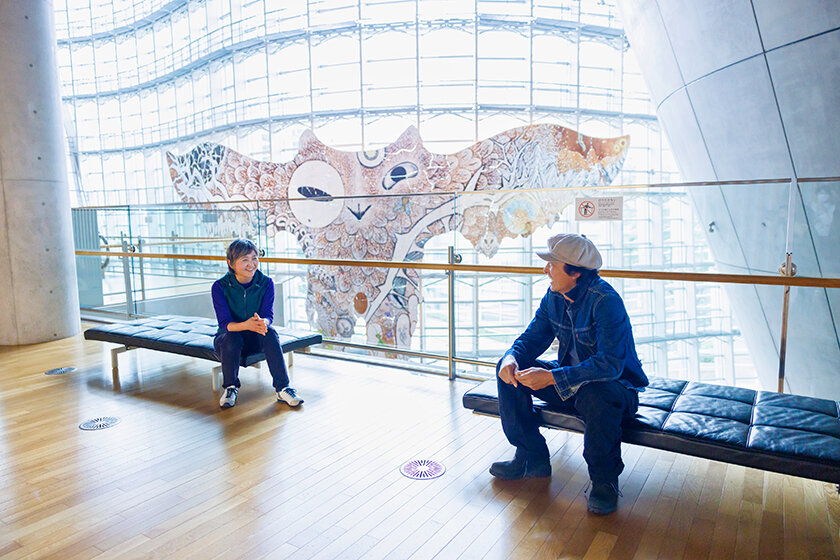

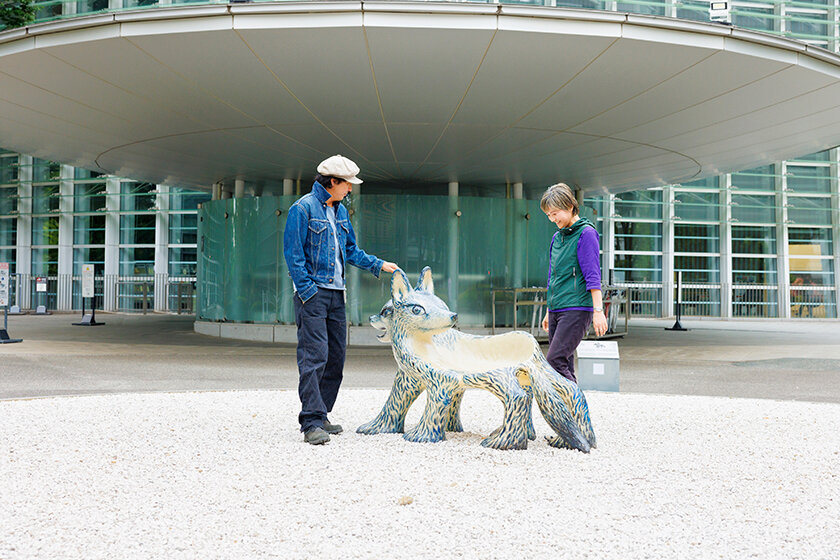
INTERVIEW
148
Tomoko Konoike × Takashi KuribayashiArtist × Artist
Seek a Personal Connection with Artwork and Artists and Strive to be Open-Minded Toward Differences.
Get a direct feel for what’s fundamental right here and now.
Tomoko Konoike strives to address primordial questions about art , while Takashi Kuribayashi, who participated in the 2022 documenta fifteen , creates ambitious installations that explore the theme of “boundaries.” These two were the Main Program Artists for the Roppongi Art Night 2023 event held in May, 2023. Their discussion during our interview took an unencumbered look at the current art scene and the existing framework of art museums, leading to questions about reexamining a fundamental premise of viewing or creating works of art—how to live life itself. Having experienced the COVID-19 pandemic, what “fundamentals” should we be going back to now?
Why does exhibiting in Japan mean artists have to "back down" or "compromise"?
Takashi KuribayashiFirst off, a lot of my work examines taboos so I'm probably not an easy artist to work with. That's why it was so interesting to me that despite that, I got the offer for Roppongi Art Night 2023, which would be an all-night affair for the first time in four years. A big premise of my work is that I don't create with exhibitions in mind at all. It's kind of a product of my way of life, of my relationship with society. So I don't tend to mesh well with events that have fixed frameworks and lots of restrictions. Event organizers in other countries are generally more open to finding ways that let artists bring their ideas to life, but in Japan the priority tends to be on the restrictions, which inevitably means I have to back down or compromise. Sometimes I finish an event in Japan and regret that I participated at all. I don't argue or fight with the organizers or anything, but I sometimes do feel a kind of difficulty there. But with Roppongi Art Night 2023, I got the sense that the organizers were ready to take the leap together, so that persuaded me to accept the offer.
ROPPONGI ART NIGHT 2023
The 2023 event was held over two weekend days on May 27 and 28, 2023. Through performances and works of art under the theme "urban life encyclopedia," the program explored how not only humans, but also animals, insects, plants, and other living creatures nurture life and coexist within the ecosystem of the city of Roppongi.
https://6mirai.tokyo-midtown.com/event/artnight_2023/
Tomoko KonoikeSo I guess we're talking about the fundamentals today. [laughs] Listening to what Kuribayashi-san said makes me think that, maybe now after experiencing three years of the COVID-19 pandemic, it's time for us to return to our fundamentals. When I first heard the concept of Roppongi Art Night--that it would be held for one night only and how everything would be taken down the following day--I responded that there's no way my people would agree to that. Something just felt very off about what sounded like a festival for the sake of having a festival, where people would set up in a rush and have a big brouhaha that would then just finish. Audience inclinations had changed during the pandemic, but it felt like the organizers had yet to realize this. We had a meeting where I caused some tension by saying, "Something of this volume should be up for at least two months. But just a day? You've got to be kidding!" I thought, "Shoot, now I've done it," but a part of me still hoped that the people at that meeting might each go and consider what I said. Then they decided that I could set up my Musashino BLACK KITE in the entrance lobby of The National Art Center, Tokyo from three weeks before the event. This decision by the museum was huge. Museums and event organizers and the like are often very rigid and uncompromising, but they allowed it partly because the location was the atrium, a borderline space outside of the museum's exhibition rooms. I thought that concession was a step forward in the right direction.
Musashino BLACK KITE
Konoike's work displayed in the entrance lobby of The National Art Center, Tokyo. Since prehistoric times, humans have hunted animals for food, dressed in their skins, and offered them to the gods. The work makes use of skins that were destined to be discarded, considered useless scraps under capitalism. The body of the kite is decorated with drawings of a variety of animals, scenery, and phenomena, and the way the bird spreads its giant wings reminds viewers of the relationship that humans have with animals and nature.
©2021 Tomoko Konoike Courtesy of Kadokawa Culture Museum
The starting point should be from the heart, not a how-to guide
KuribayashiSpending three months or so preparing for a single day is tough, but we're happy to put in the effort if we sense how passionate the people involved in the event are. But when all of the communication consists of rules and business-related stuff like "Please install your work by this date and time and clear out by this date and time," it starts getting tiresome because we aren't event producers, you know? It may seem like a small thing, but I think now might be the opportune time to change the overall attitude of people involved in art. I think the starting point should be from the heart, rather than sticking to a how-to guide from start to finish.
I think that kind of attitude is also to blame for how young people these days want instant answers, asking questions like "How do you become famous?" or "How do you make money?" Because society keeps trying to show young people what's "supposed" to happen in the future, they can't focus on what they should be doing in the moment, right here and now. The overemphasis on the economy means people stress the importance of what needs to be done for the future, but I think a focus on enjoying the present actually paves the way for the future instead, and that's how things should be. When the future is the starting point, anxiety and fear take precedent and prevent people from focusing on the present.
I often say that "deciding on the fly is a key." Living without thinking is natural for most creatures, and once people lose their animal instincts they start using their heads for everything. Artists are capable of implementing the things that come instinctively to them, and our work keeps time with the flow of the seasons. I wish more people would realize that, and agree that we need to change the status quo, however hard that may be.

Japan considers artist requests to be "unreasonable"
KuribayashiI'm pretty sure Konoike-san goes and does what she wants even in Japan with a "the heck do I care" kind of attitude. [laughs] I say this to mean she's that wonderful of an artist, of course. My work usually makes use of the features of a space rather than functioning as a standalone piece, so the question of whether it will actually materialize is a regular struggle. When that happens, it's easy to say "it's not possible," but at least giving it a try no matter what is very important. But somehow, Japan often views that kind of thing as artists being "unreasonable." For example, my GENKI-RO that involves a steam sauna uses firewood, and making a fire obviously results in smoke, as well as a smell. So if we want to set it up, it makes sense that we first need to come up with a way to address those issues, right?
GENKI-RO
This steam sauna made to look like a nuclear reactor (genshi-ro) is a work that Kuribayashi, who loves Thai herbal saunas, initially devised more than twenty years ago. After the 2011 Great East Japan Earthquake Kuribayashi made art about the nuclear reactor accident, and this particular work is "an attempt to positively express the negative nuclear power problem." In 2020, Kuribayashi introduced the "First Machine" at a solo exhibition at Nizayama Forest Art Museum, a museum converted from an old power plant. He has since been setting up more.
The documenta fifteen event I participated last year was pretty reasonable and agreed that "if it caught on fire, we could just put it out ," which makes perfect sense to me, and they prioritized thinking about more important issues. In Japan, so many things aren't allowed because they are worried that visitors touching a work will break it. But if it breaks we just have to fix it, and although this may be a bit extreme, I think that people interacting with artwork despite a little burn or scrape is actually ideal. Maybe I just feel that way because I'm based in Indonesia. In that sense, Konoike-san and I being invited to Roppongi Art Night was really interesting, as well as adventurous. Especially considering the way I am and the way Konoike-san is. [laughs]
documenta
A large-scale international contemporary art exhibition which has been held every five years in Kassel, Germany since 1955. In terms of importance, it is one considered on par with the Venice Biennale, the oldest international exhibition of its kind. Kuribayashi was the only Japanese artist invited to participate in the documenta fifteen event held in 2022.
out of the mosquito net, Takashi Kuribayashi + Cinema Caravan, documenta fifteen (Kassel, Germany), Karlsaue
photo Takashi Kuribayashi
KonoikeWhat you just talked about suddenly reminded me of something that I know sounds super dull. For the Roppongi Art Night event, the trucking company gave us an estimate for deinstallation as needing three 4-ton trucks. The budget was already fixed so it didn't matter if we used two or three trucks, but I was sure we only needed two. I made up a hand-drawn diagram of how the pieces could be loaded on the trucks and convinced the company to just use two. I just think it's funny how much effort I put into that. [laughs]
But I guess it's those dull things that we need to be doing more regularly, myself included. What I mean to say is, artwork isn't about flashy appearances. What Kuribayashi-san is saying is really just a matter of fact.
KuribayashiRight, there's nothing special about it.
Stop thinking about the future for a moment and look at where we stand
KonoikeI think we should stop thinking about the future for a moment and look at where we stand. We don't have to go into some mountains far away to find nature. You can find it right here in Roppongi. You don't need much. Just finding joy in the smell of the wind--the smell of green foliage growing richer in the current season--is good enough. The important thing is whether you are present to feel those things. I think now we are in an age where it's not about organizers providing something novel to see. It's about active, audience-led experiences that broaden sensibilities. Instead of going about things in a sight-focused way where people observe things far and wide, it's much better for everyone to first get a feel for the soil and weeds right at their feet and enjoy focusing on carrying out their individual jobs.
As Kuribayashi-san said, if something catches on fire we can just put it out quickly ― if a person takes things too far, someone can just stop them. Much like the maternal inclination to issue preemptive advice like "that's dangerous" or "you can't do it this way because it won't work," museums now are ruining the cautionary sensors that people innately have. Perhaps it's an instinctive desire on their part, but every time I work with a museum I feel like I'm gradually getting less capable, and it makes me want to expose myself more to the outside world.
KuribayashiAfter experiencing the freedom of creating something like GENKI-RO, I have so much trouble dealing with all the restrictions when exhibiting at a museum that it stifles my ability to even do things that I should be able to do. What's the point in that? Even if the pandemic hadn't happened, I'm sure people would have felt the same kind of awkwardness sooner or later.

The important thing isn't about relating with others, it's getting your own, direct feel for something with an open mind
KuribayashiThis may not be the right choice of words, but a part of me doesn't care about other people. I don't mean I'm egotistical or don't like others, but I feel like I need to focus on myself and charge my own energy up or else I end up taking it from others.
KonoikeTrue, it leads to being overly dependent on someone else.
KuribayashiI can give to others if I'm feeling fulfilled. So when I'm feeling frustrated, I go do something I enjoy, like going to the beach or surfing. When I try to figure out and control my condition, it's better for me not to interact with people too much. But society today always tends to try to interact with you. Forcing an interaction is the biggest problem. When people don't interfere and are open-minded enough to let each person express their individuality and do what they like, it creates a positive cycle. Ideally, everyone should be able to say what they want and instead of responding, "No, that doesn't make sense," it's much better to say, "I see your opinion. My opinion is different, and this is what I think." I think that's how individual artists should be, and that's what sets each apart.
Recently, I've had interaction with some Ainu people, who culturally don't interfere with others too much. For example, the act of making something is a way to show gratitude to the gods, not for showing others. I found that very interesting when I first heard it, and I thought it's something I need to reconsider as an artist.
KonoikeWhen you are within the same framework, you inevitably start reusing the same mold for everything. You can bring in a new artist or designer from somewhere to change appearances as a makeshift measure, but it's still the same mold, just customized or updated. Things tend to get stagnant. So it doesn't matter if the end product is clumsy, or underdeveloped and awkward. If you don't do at least one little thing you ought to be doing, nothing will ever change fundamentally. It's the same with museums. They get stuck being a place for people to discover whatever it is they call artwork, an appealing enough experience that's a step away from everyday life, nothing more. That expectation is so strong that museums increasingly conform to that image, and that's scary because at some point simply putting something in a museum makes it art.
Personally, I'm counting on the potential of those who see the art--the viewers and the beholders. Not what the creator feels, but what the viewers feel. It's important for the beholders to see a work with their own eyes and to learn with an open mind, even if the work is something they don't like or aren't interested in. Being able to relate with someone else can wait. People have no problem doing that as individuals, but once in an organization they suddenly get influenced by fixed practices and convention. That's why it's important to first explore what you feel as an individual.
KuribayashiThe context of fine art is important of course, as well as having people who research or critique it, but that's not the whole story. What I mean is, the people who critique my work try to fit it in some kind of context, but I don't think that's really possible. A lot of time has passed since the very first appearance of what we call contemporary art. With all the markets and art scenes that have sprung up, I realize it's inevitable that there's now a kind of fixed way of looking at contemporary art. You can try to look for something new, but there's nothing new anymore. So I think we should forget about context or other extraneous stuff and each just be involved at a personal level. I don't intend on creating new context when I work, but I do go about it as free and uninhibited as a child.
KonoikeAnd if something fails, it shouldn't be one person writing a letter of apology. Everyone involved should consider what mechanism led to the failure and be concerned about what needs to be done. Not for the sake of administrative or museum facility management considerations and such, but for the sake of the artist as an actual, individual person. I don't think that's being done at all right now.
Humans seem like they're in control of themselves, but really aren't
KuribayashiIn the past, there were a lot of places like GENKI-RO. Saunas and bathhouses were places for local communities to gather. But as life became more Westernized those kinds of facilities dropped in number, and people's average body temperatures actually dropped . The masks we wear keep germs out as well, and our immune systems are getting weaker. I finished GENKI-RO during the pandemic, and I wanted to use art to compel people to get healthier. If I called it a "sauna" public health inspector regulations would get messy, but as long as it was an "art experience," I could keep that part of it vague. People nowadays tend to be anxious or unhealthy, resulting in unenjoyable circumstances, but I'm sure there would be a lot more energy if something like the GENKI-RO popped up all over the city. I think that's the type of thing that makes creating art meaningful. The theme of the recent Roppongi Art Night was "urban life encyclopedia," but I think of it more as a "human encyclopedia." When you talk about an encyclopedia on "urban life," you tend to think of plants or animals or insects, but humans are the most bizarre in my opinion.
KonoikeTrue, humans seem like they're in control of themselves, but really aren't. Having an animalistic nature within means you never know when human reason will break down. We live our lives in peace oblivious to that fact, but people can be triggered into raging out of control sometimes, you know? If an environment changes completely, humans are liable to change just as quickly.
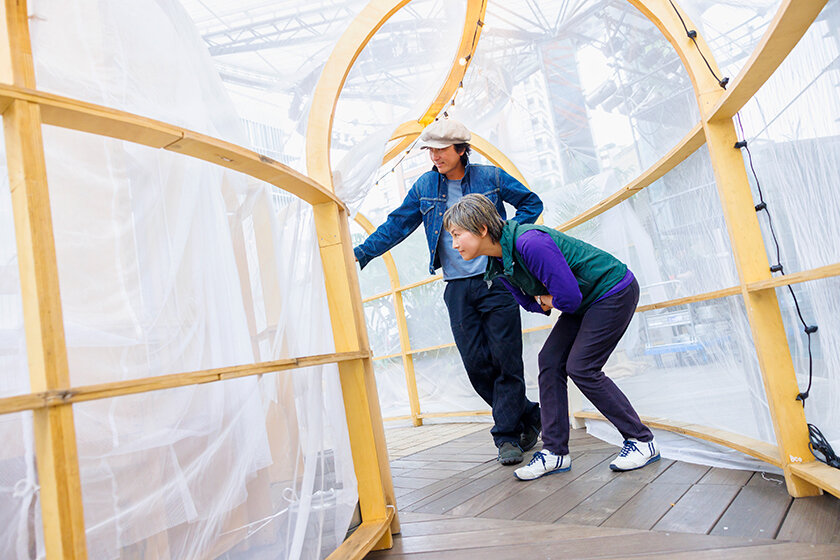
A direct, personal feeling that can't be attained from secondary information
KuribayashiIn Yogyakarta, a city in Indonesia that I love, almost no one sounds their horn even if the road is crowded. Sometimes people even drive the wrong way on the road, but no one complains, and there's a general assumption that those people must have a reason for driving the wrong way. For example, you know how there are times when you could make your turn if you went back 15 meters in the wrong direction, but the proper way takes you the long way around? In that kind of situation, what happens is that everyone starts driving the wrong way in that particular location. In general, you're supposed to follow the traffic lights and you can't drive the wrong way, but the city has a kind of flexibility that says, "it's okay to do that just there."
KonoikeThat's really nice.
KuribayashiThat's how things should actually be, right? It doesn't make sense to be waiting at a red light when no one else is there. If you don't trust that people will follow the rules, you never cross without thinking, even if the light is green. You're always careful. That way, less accidents actually happen. Not trusting others allows for freedom, and actually means you do trust them, in a sense. I think that kind of flexibility in Japanese cities would make things more fun.
KonoikeToday, everyone is so thirsty for visual information and is constantly bathed in a stream of data. Meanwhile, I feel like that information isn't resulting in any substance. I really think people should be using their hands and legs instead of their eyes, even if it takes more time. Physically go see artwork that's supposed to be good and if it's actually kind of boring, see that for yourself. Despite what other people get out of it, discover how you feel from the experience. Difference is a good thing. Secondary information in the form of orderly data isn't going to inspire realizations deep within your soul. If you run into some kind of problem along the way, internalize that as a part of the experience and take your time to put it into words. Even if you can't express your feelings properly on the spot, it's fine if you can explain it ten years down the line. The important thing is to retain that feeling you get. I think it's important to get what you can out of whatever's tangible right at your feet instead of straining to see what's in the distance, and both Kuribayashi-san and I create things that way.
KuribayashiYou're exactly right. The reason my GENKI-RO isn't just any sauna but specifically a steam sauna is because the steam prevents people from seeing around them.
KonoikeOh, I see!
KuribayashiInformation you get through your eyes is directly connected to the brain and uses a lot of brainpower, but once you shut down your eyes the focus kind of shifts to the heart. Other senses like hearing and smell get keener, helping you relax. I think everyone realizes this instinctively, but although humans seem like they're driven by their brains, more often than not they're driven by their hearts. You know how they say your blood rushes to your head when you're angry ? When you're angry your heart is surprisingly quiet, and you're just angry up in your head. But when you're sad or happy, it's your heart that drives those emotions instead of your head. That's why once you can identify whether an emotion is driven by your brain or your heart, like considering "Am I thinking I'm happy with my brain? No, that's not it," I think you can really be true to yourself in life. As Konoike-san was saying earlier, touching and experiencing artwork without relying on your eyes is great. In an ordinary sauna everyone sits still and doesn't talk, but in a steam sauna people are more relaxed because they can't see each other, and that makes for good conversation. It often results in funny things, like finding out you actually knew the person once you both get out.
How to get a deeper feel for the artist and artwork
KonoikeI think whoever decided to ask us to participate in Roppongi Art Night made the right choice, but a part of me wishes that the organizers were more familiar with our work if they were going to invite us.
KuribayashiYou mean you wanted them to know just how much more interesting we can actually be, right? It's a little frustrating not being allowed to fully express ourselves. There's no point in self-praise, but there are many times when I think something is a waste of our potential.
KonoikeOur goal isn't just about making artwork, and exhibitions are just a particular moment in living our lives.
KuribayashiIt's a small part. An instant.
KonoikeYes, I think of exhibitions like a quick stopover on a longer journey. But an exhibition brings a group of people together whose paths might never cross again, so we might as well make it interesting and put our hearts into it. In order to do that, I think it's essential for everyone involved, including facility owners and organizations, to start changing the way they think. In order to get to know the artist, maybe it would help to be involved in installing the artwork. Maybe whoever's helping might be useless on site and get yelled at from start to finish, and end up wandering around with no idea about what to do, but that's okay. When you see other people at work, you realize unexpected details that they're really particular about.
KuribayashiThere might be a bunch of surprises to see how things are actually made.
KonoikeEven if you don't like a work of art at first glance or you aren't interested at all, you might discover some surprising things about it once you get involved. I had gotten bored of looking at most artwork in museums, but once I helped other artists install their work and talked with them I made so many unexpected discoveries, and I realized that different people value completely different things. You have to understand those differences to be open-minded about others. It's really easy to dismiss something as boring, but perhaps what makes art interesting is that even if something looks silly or boring, you can tune into those curious sensors that humans innately have and get involved.
Photo location: Roppongi Art Night 2023 (dates: May 27 to May 28, 2023), The National Art Center, Tokyo and Roppongi Hills Arena
Editor's thoughts
This interview took place the day before the actual Art Night. The two really spoke their minds from one thing to the next. Some may consider their comments harsh, but as they mentioned repeatedly, right now is the opportune time to change. Whether you are directly involved with art or not, it's important to deal with what's right in front of you and take a sincere look at where you stand. The thing that really left an impression on me was the idea that focusing on the present and not the distant future will actually help create a brighter tomorrow. (text_ikuko hyodo)
RANKING
ALL
CATEGORY




